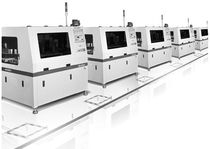Press-fit Technology: Creating robust solderless interconnects
The Need for Automation-ready Solderless Interconnects
Creating on-board interconnect solutions is an area of significant challenge for the implementation of lead-free soldering processes. One key area for high volume manufacturers is maintaining overall production efficiency. The secondary soldering processes that have been traditionally required for attaching large connectors and other specialized interconnects are very difficult to convert to lead-free processes. This is especially challenging for heavy copper PCBs such as power interconnects.
Press-fit (compliant) pins have been around for more than 20 years, with extensive utilization in several targeted markets. Press-fit (compliant) technology incorporates a special design of the insertion section of each pin, which provides a robust and reliable gas-tight interface with the plated-through hole and does not require any subsequent soldering step.
The insertion section of the pin is larger than the diameter of the hole but is designed to deform during insertion, which creates a strong friction-fit between the pin and the plated-through surface.

Eye-of-the-Needle Design
Over the years, a number of different design approaches have been used to provide the resilient fit necessary for compliant pins. As press-fit (compliant) technology moves into new applications such as Smart Junction Boxes, in the automotive industry, it is critical that the force between the pin and the plated-through surface remain adequate to withstand environmental and mechanical factors such as heat, humidity, vibration, shock and other rugged conditions that are inherent within an automobile environment.
The “eye-of-the-needle” approach has been proven to provide the most reliable technology for optimizing both initial and on-going retention force. The spring-like design used in eye-of-the-needle configurations provides intimate long-term contact force against the barrel of the hole.

Operating temperature for all pins is -40 to 125 C, and they can withstand 125 C for 1,008 hours. Right-angle pins (single and double row) are also available for joining perpendicular PCBs. All products are offered with RoHS lead-free plating.
Connectors are molded of durable plastic with a wide range of pins. They may contain as few as three pins, and as many as 256 pins.”: says Assembly Magazine in its article on Press-fit connectors and their advantages.


Current-Carrying Capacity
Press-fit (compliant) terminals have excellent current capacity and can be especially helpful for power interconnects on heavy copper boards, which can be hard to solder and therefore are more difficult to transition into lead-free environments. Instead of having to tweak or adjust reflow process parameters to meet special soldering challenges for heavy copper PCBs, manufacturers can establish relatively wide mainstream process control windows and eliminate special soldering requirements by using compliant interconnects for high-current applications.
Tested for Reliability, Retention Strength & Environmental Resistance
Autosplice eye-of-the-needle Press-fit (compliant) technologies have been extensively tested to assure compliance with a number of key industry requirements, including SAE/USCAR-2, Rev4, EIA Publication 364 and IEC 60352-5 specifications. The testing process used systematic evaluation of environmental, mechanical and reliability factors under controlled conditions.
Testing was conducted for a range of different Press-fit (compliant) interconnects and PCB types (including copper plating, gold plating and HASL finish). All test samples were fabricated and assembled utilizing normal production techniques and quality criteria.
Specific testing included vibration, thermal shock & thermal life, mechanical shock, insertion force, retention strength, humidity, current cycling and contact resistance. All interconnect designs consistently passed with no damage and/or conformance with specified parameters.
Compliant Pin Specifications, Configurations, Options
Press-fit (compliant) interconnects are currently available from Autosplice in the following configurations:
Discrete terminals (blades, tabs, etc.)
Continuous-reeled pins
Press-fit headers on continuous reels or pre-cut lengths (one-by or two-by)
Square or round (industry standard or custom diameters & pin lengths)















